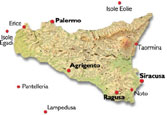|
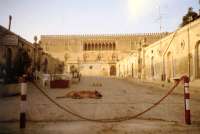 This is not of course the Donnafugata so lovingly described in Il Gattopardo (The Leopard) by Giuseppe Tomasi di Lampedusa: that was at S. Margherita di Belice. If you visit S Margherita, however, you will be saddened by the pitiful remains of the vast gorgeous palace where Tancredi and Angelica could wander and make love undisturbed. Surprisingly perhaps then, this Donnafugata - with no connection to the Leopard except its name - will compensate for the dilapidation of the original. For the Castello di Donnafugata is a very fine palace indeed, with 122 rooms - less than Don Fabrizio's but still impressive. The first floor has now been restored to its original beauty, but the extensive grounds still await regeneration. This is not of course the Donnafugata so lovingly described in Il Gattopardo (The Leopard) by Giuseppe Tomasi di Lampedusa: that was at S. Margherita di Belice. If you visit S Margherita, however, you will be saddened by the pitiful remains of the vast gorgeous palace where Tancredi and Angelica could wander and make love undisturbed. Surprisingly perhaps then, this Donnafugata - with no connection to the Leopard except its name - will compensate for the dilapidation of the original. For the Castello di Donnafugata is a very fine palace indeed, with 122 rooms - less than Don Fabrizio's but still impressive. The first floor has now been restored to its original beauty, but the extensive grounds still await regeneration.
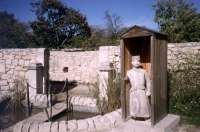 I've been there three times - the first time (August 1993) neither house nor garden were accessible. It was a quiet remote place, where dogs snoozed in the sun. The second time, I was allowed to wander around the decayed gardens - and even explore (and get lost in ) the great stone-walled maze. There are many fine trees in the garden - including a huge Magnolia, and, besides the maze, a tempietto and artificial grottoes. On my third visit - in 2005 - there were coach parties of schoolchildren in their colour-coded baseball caps (green, yellow and red), and a large restaurant had opened to provide them with lunch. But the gardens were closed! I've been there three times - the first time (August 1993) neither house nor garden were accessible. It was a quiet remote place, where dogs snoozed in the sun. The second time, I was allowed to wander around the decayed gardens - and even explore (and get lost in ) the great stone-walled maze. There are many fine trees in the garden - including a huge Magnolia, and, besides the maze, a tempietto and artificial grottoes. On my third visit - in 2005 - there were coach parties of schoolchildren in their colour-coded baseball caps (green, yellow and red), and a large restaurant had opened to provide them with lunch. But the gardens were closed!
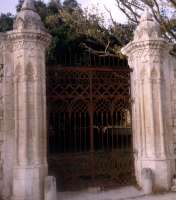 The name Donnafugata is probably now best known for fine Sicilian wines - confusingly, these do not originate either from this Donnafugata in Ragusa province or from S. Margherita di Belice, but from Contessa Entellina in Trapani province, not far from Segesta. [it is close to the site of ancient Entella, along with Eryx and Segesta, once a town of the mysterious Elymians]. Incidentally, the name has nothing to do with a lady who's run away, or been kidnapped, but derives eventually from Arabic Ayn as Jafat (fountain of health). When I first enjoyed the wines - in Lipari - they were all named after characters in the Leopard - this no longer seems to be the case (2005) although there is one called Lighea, which reminds one of a short story by Lampedusa. They also produce Marsala and the exquisite Passito di Pantelleria (I always bring a bottle or two back from visits to Sicily). The name Donnafugata is probably now best known for fine Sicilian wines - confusingly, these do not originate either from this Donnafugata in Ragusa province or from S. Margherita di Belice, but from Contessa Entellina in Trapani province, not far from Segesta. [it is close to the site of ancient Entella, along with Eryx and Segesta, once a town of the mysterious Elymians]. Incidentally, the name has nothing to do with a lady who's run away, or been kidnapped, but derives eventually from Arabic Ayn as Jafat (fountain of health). When I first enjoyed the wines - in Lipari - they were all named after characters in the Leopard - this no longer seems to be the case (2005) although there is one called Lighea, which reminds one of a short story by Lampedusa. They also produce Marsala and the exquisite Passito di Pantelleria (I always bring a bottle or two back from visits to Sicily).
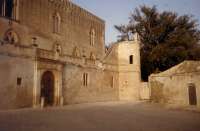 |
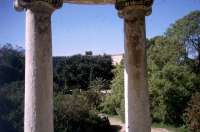 |
The oldest part of the Castello dates back to the 17th century, but most of it has been much altered. The facade is from the last century - although its elegant Venetian Gothic style makes it look much older. The upper floor is now (2005) open to the public for a modest charge, but photography is not allowed. I therefore made full descriptions of the rooms - examples below (with illustrations from old postcards):
Sala della Musica (Music room)
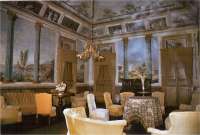 Walls in trompe l'oeil; on each wall green/blue Corinthian columns with gold capitals and bases, with views beyond. To the left: a harbour - calm sea, sailing ships, a river mouth, fishermen on the rocks, a castle on a rocky island linked to a town by bridges, all reflecting in the calm waters, which are blue/green (ie bluer than the columns!). Walls in trompe l'oeil; on each wall green/blue Corinthian columns with gold capitals and bases, with views beyond. To the left: a harbour - calm sea, sailing ships, a river mouth, fishermen on the rocks, a castle on a rocky island linked to a town by bridges, all reflecting in the calm waters, which are blue/green (ie bluer than the columns!).
Next wall, to the right: a palace in a park with hills in the background and railings around it. It has two doric pilasters, with matching columns on the shadowed side. Two lions/sphinxes flank the entrance. A lady in red accompanied by two gentlemen stands in the wide drive, with another to her right, with cane and tailcoat.
Next wall (opposite the first picture): a massive palace with grand staircases, an obelisk. There is a dome and wings with dozens of doric columns. There's a tempietto on a rocky hill to the right, and Mt Etna is in the background. Figures walk on the broad drive in front.
Next: A castle in a small lake; a willow on the right; soldiers with muskets; a girl in a green skirt with two baskets; a seated man in a red suit; some sheep; a well-dressed shepherd.
The frieze has: fruit, fish, sculpture, mathematical instruments, rabbits and a partridge with a rifle, astronomical instruments, ladies' fans, jewels, eau de cologne, mirror, musical instruments - a violin, horn and accordion with sheet music. The ceiling is a pale blue/green decorated with harps and floral motifs, and a zodiac. There are yellow sofas and chairs arranged around two small round tables. Various old pianos and other instruments are also present.
Appartamento del Vescovo (Bishop's apartment)
 Sala: Upholstery (including the tablecloth) is a deep rose. There's a chandelier, and a gilded mirror above a gilded table; a portrait of a grumpy-looking cleric; a large china pug dog. A square ceiling picture has Cupid and four ladies; a chariot with swans is in the background. There's a picture of (?) Christ surrounded by angels offering a flan, fruit, wine etc. Stanza da letto contains a very substantial double-bed. The blue wallpaper with a lacy motif looks like the sky seen through lace curtains. On the ceiling is a picture of Venus in bed with four cute cupids (one Black, holding a mirror). There's a signed photo of Vittorio Emanuele! Sala: Upholstery (including the tablecloth) is a deep rose. There's a chandelier, and a gilded mirror above a gilded table; a portrait of a grumpy-looking cleric; a large china pug dog. A square ceiling picture has Cupid and four ladies; a chariot with swans is in the background. There's a picture of (?) Christ surrounded by angels offering a flan, fruit, wine etc. Stanza da letto contains a very substantial double-bed. The blue wallpaper with a lacy motif looks like the sky seen through lace curtains. On the ceiling is a picture of Venus in bed with four cute cupids (one Black, holding a mirror). There's a signed photo of Vittorio Emanuele!
Sala degli Specchi (Room of mirrors)
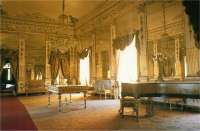 The day I visited, there was an artful scattering of white pebbles on the floor. The large marble table held silver flasks and glass rods. The grand piano was topped by a very large silver flask. There are mirrors on all sides of the room, surmounted by a gilded frieze; the large windows have gold and lace drapes. There is a spectacular chandelier. The overall effect is breath-taking: a room that seems to distil the essence of Sicilian sunshine. There are 8 stools and 2 sofas upholstered in very pale pink/brown brocade. The day I visited, there was an artful scattering of white pebbles on the floor. The large marble table held silver flasks and glass rods. The grand piano was topped by a very large silver flask. There are mirrors on all sides of the room, surmounted by a gilded frieze; the large windows have gold and lace drapes. There is a spectacular chandelier. The overall effect is breath-taking: a room that seems to distil the essence of Sicilian sunshine. There are 8 stools and 2 sofas upholstered in very pale pink/brown brocade.
Salone degli Stemmi (Hall of the Shields)
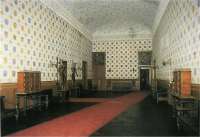 Another amazing room. The wallpaper consists of hand-painted shield motifs - it appeared that no two were the same. The ceiling is interlaced octagons and squares on a very pale blue background. There are two suits of armour, and several black leather sofas. Another amazing room. The wallpaper consists of hand-painted shield motifs - it appeared that no two were the same. The ceiling is interlaced octagons and squares on a very pale blue background. There are two suits of armour, and several black leather sofas.
|

